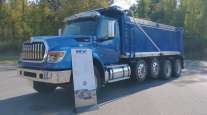Navistar 1Q Net Loss Widens to $62 Million on Weak Sales

This story appears in the March 13 print edition of Transport Topics.
Truck and engine maker Navistar International Corp. reported fiscal first-quarter results that showed widening net losses, with the anemic North American new truck sales market causing most of the problems.
Navistar lost $62 million, or 76 cents a share, for the period ended Jan. 31. That compared with a loss of $33 million, or 40 cents in the same year-ago period.
The Lisle, Illinois-based original equipment manufacturer said sales declined by 5.8% to $1.66 billion from $1.76 billion.
Among the company’s four major divisions, parts remained profitable at a similar level to a year ago, the loss at global operations narrowed by more than two-thirds and profits at financial services declined by 50% but remained in the black.
At the truck division, though, sales declined by 5.9% to $1.02 billion for the quarter from $1.08 billion a year ago. The division’s quarterly operating loss accelerated to $69 million from $51 million.
The company’s core market is Class 6 to Class 8 trucks and buses in the United States and Canada.
“This was primarily driven by market pressures, the impact of lower core market volumes, and a decrease in other income,” the company’s earnings statement on March 7 said.
Chairman and CEO Troy Clarke remained optimistic, saying that when industrywide truck sales return, perhaps as soon as the second half of this year so, too, will Navistar.
“Our results are on track with our plan for the year and demonstrate our ability to effectively manage costs at a time of persistent Class 8 industry headwinds,” Clarke said.
“Our order share continues to outpace our market share, which confirms our confidence in the retail share improvement to come. At the same time, we are rolling out a steady stream of new product introductions that are helping us generate new sales opportunities and position us to take advantage of the anticipated Class 8 rebound in the second half,” he added.
Navistar released its earnings report a week after it announced it has completed an alliance agreement with Volkswagen’s Truck & Bus division, and it unveiled its new, 12.4-liter A26 engine for highway tractors.
In its 21 most recent fiscal quarters, the company has posted positive net income twice: the three-month periods ended April 30, 2016, and July 31, 2012.
Navistar’s problems started in 2012, when previous management botched a choice of diesel engine technology. Clarke has led the clean-up effort since 2013 when he became CEO. Several financial analysts who follow the company agreed that Navistar is in decent shape and just needs a robust North American truck sales market.
The fiscal first quarter “is seasonally Navistar’s weakest quarter of the year, but we saw several encouraging signs. The company noted it is on track to meet previous guidance, although end-market discussions sounded incrementally positive,” said Stephen Volkmann of Jefferies Securities.
“We believe the strategic alliance with VW provides a blueprint to eventual full ownership by VW, though this is likely years away rather than measured in quarters. The alliance provides VW access to the North American market, including Navistar’s strong dealer network, and global purchasing synergies, as well as a full family of drivetrain technology,” Volkmann said.
David Leiker of Robert W. Baird & Co. said the company’s “business model is much improved,” but he also had a bad news-good news assessment.
“The market share recovery needed to drive volume, operating leverage and earnings meaningfully higher has been stubbornly absent,” Leiker said.
More encouraging though, he said: “Operating performance has become more predictable, raising our confidence in analyzing the business. For longer-term investors, we believe the stock is increasingly attractive, considering the strengthened balance sheet, new product flow and future cost savings from its alliance with Volkswagen, which also reduces downside risk. Near-term risks remain elevated.”




